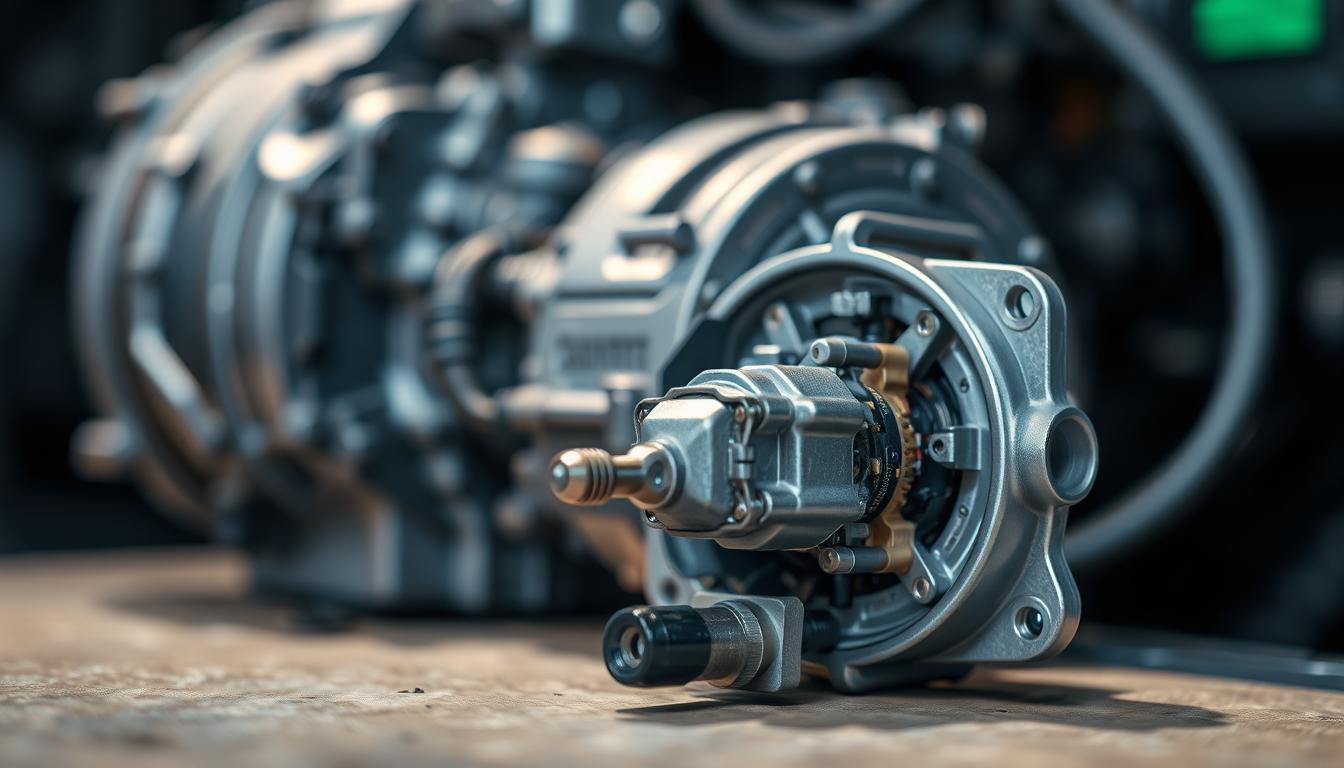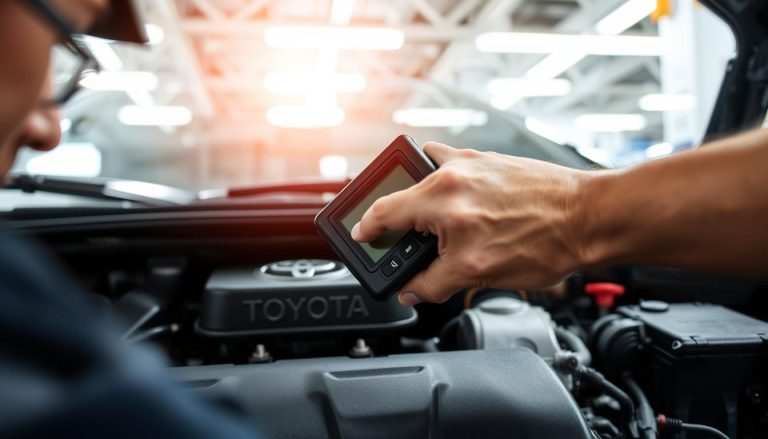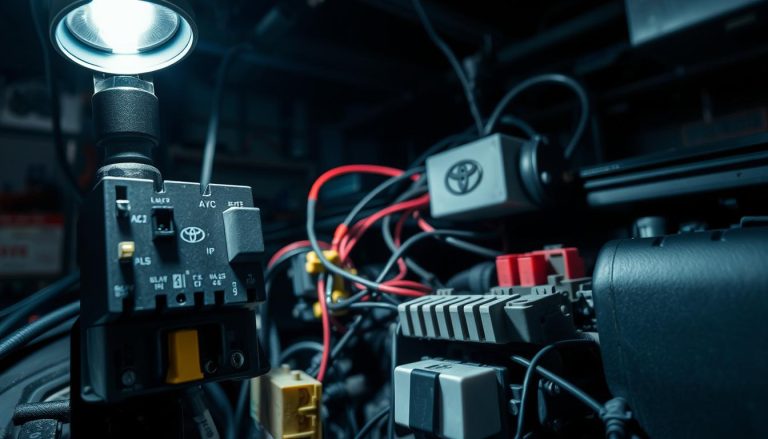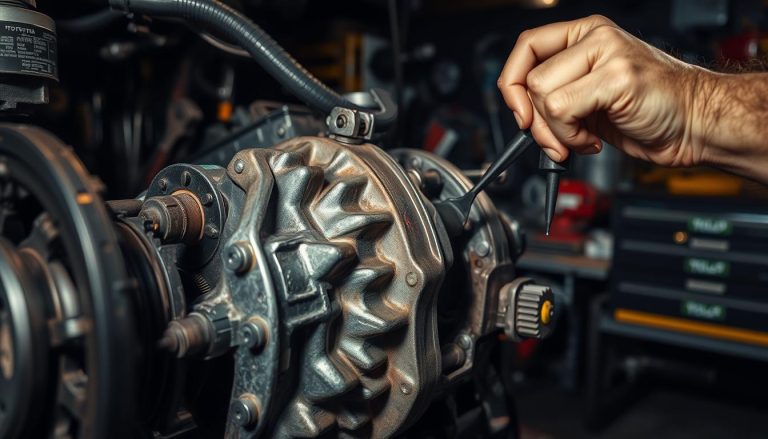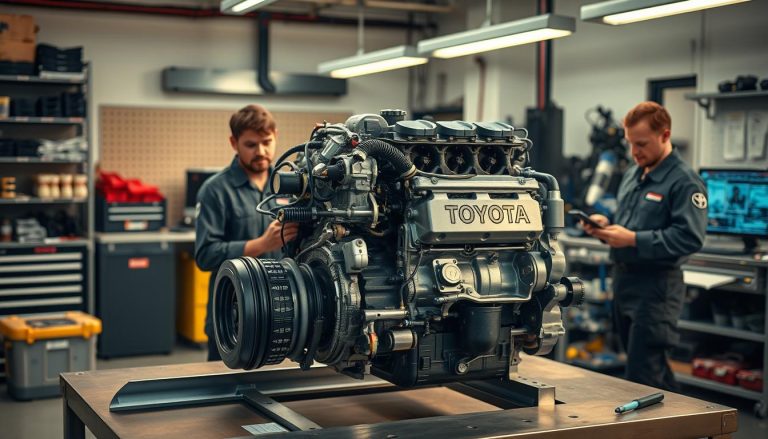Toyota Shift Solenoid Issues: Causes & Fixes
Having trouble with your Toyota’s transmission? You’re not alone. Toyota shift solenoid problems are common and can affect many models. These small parts are key to smooth gear shifts.
When they fail, you might see delayed shifts or get stuck in a gear. You could even have trouble changing gears. This guide will help you understand and fix these issues.
What is a Transmission Solenoid?
A transmission solenoid is key in modern automatic transmissions. It controls the flow of transmission fluid for gear shifting. The engine or transmission control unit (TCU) tells the solenoid when to open or close valves. This lets fluid reach the bands and clutches for smooth gear changes.
Function and Operation
Transmission solenoids work like valves, controlled by electricity. When the TCU sends a signal, the solenoid opens or closes. This controls the fluid flow, essential for gear engagement and disengagement. Knowing how solenoids work helps in fixing problems and spotting failures.
Types of Transmission Solenoids
There are many types of transmission solenoids, each with its own job:
- Shift Solenoids: These control the fluid flow to the gears for smooth shifts.
- Lockup Solenoids: They manage the torque converter’s lockup, improving fuel efficiency.
- Control Solenoids: These keep the transmission pressure right for best performance.
Knowing about these solenoids helps car owners tackle common issues and fix problems more effectively.
Signs of a Failing Transmission Solenoid
It’s important to know when your transmission solenoid is failing. Signs like delayed or unpredictable gear shifting, skipping gears, and trouble downshifting or upshifting are common. Catching these early can save you from costly repairs.
Delayed or Unpredictable Gear Shifting
Delayed or unpredictable gear shifting is a big red flag. Your Toyota might hesitate before shifting gears or shift unexpectedly. Fixing this quickly can stop bigger problems from happening.
Skipping or Getting Stuck in Gears
When your car skips gears or gets stuck, it’s a sign of solenoid trouble. This happens when the solenoid can’t control the transmission fluid right. Keeping up with maintenance and replacing the solenoid early can help.
Inability to Downshift or Upshift
Not being able to downshift or upshift is a clear sign of solenoid failure. If your car has trouble shifting, it can affect your driving and safety. Knowing these signs helps you get the solenoid replaced and fix your Toyota’s transmission issues fast.
Common Toyota Shift Solenoid Problems
Toyota cars are known for being reliable. But, even the best cars can have faulty shift solenoid issues. It’s important to know about these problems to fix them quickly and keep your car running well.
Toyota Models Commonly Affected
Some Toyota models are more likely to have solenoid problems. The Toyota Camry, Corolla, and Tundra are examples. These cars often have issues with their shift solenoids, which can affect how well they shift gears.
Owners of these models should watch out for any signs of trouble. This is because these problems might happen more often than in other cars.
Electrical and Mechanical Issues
Electrical and mechanical problems can also cause issues with the shift solenoid. These include:
- Problems with the solenoid coil that affect how well it conducts electricity.
- Damage or wear in the valve body that can cause mechanical issues.
- Contamination in the transmission fluid that can make the solenoid work poorly.
Knowing about these issues can help Toyota owners fix their shift solenoid problems. This ensures their cars run smoothly and reliably.
Causes of Transmission Solenoid Failure
Knowing why solenoids fail can help keep your car’s transmission working well. Solenoid failure is common and can happen for many reasons. Each reason affects the solenoid in its own way.
Wear and Tear
Wear and tear is a big reason for solenoid failure. Solenoids get worn out from constant use. This is more common in older cars, where the solenoid has been used a lot.
Dirty Transmission Fluid
Dirty transmission fluid is another big problem. It can block the solenoid’s parts, making it not work right. Keeping the transmission fluid clean is key to avoiding this issue.
Electrical Issues
Electrical problems can also cause solenoid failure. Issues like bad wiring or wrong voltages can mess up the solenoid. Checking the car’s electrical system often can help find and fix these problems.
Diagnosing Shift Solenoid Issues
It’s important to correctly diagnose shift solenoid problems to fix your vehicle right. Here’s how to identify and solve these issues:
Using an OBD-II Scanner
An OBD-II scanner is key for finding transmission problems. It connects to your car’s diagnostic port. This lets you see error codes that show shift solenoid issues. It’s great for fixing solenoid problems in Toyota cars.
Symptoms to Look For
Knowing the signs of a failing shift solenoid helps diagnose problems. Look out for:
- Delayed or unresponsive gear shifts
- Unexpected grinding noises during shift changes
- The vehicle getting stuck in a single gear
- Check Engine Light activation
Professional Diagnosis
Even with an OBD-II scanner and knowing symptoms, sometimes you need a pro. Car experts use special tools and know-how. They find the real cause of Toyota shift solenoid problems. This ensures a good fix.
Repairing and Replacing Transmission Solenoids
Identifying a faulty shift solenoid is the first step. You then decide if you’ll fix it yourself or get a pro. Fixing your Toyota’s transmission right can stop more problems and keep your car running smoothly.
Cost Estimates
Cost matters when replacing a shift solenoid. Here’s what you might pay:
| Service Type | Estimated Cost |
|---|---|
| DIY Shift Solenoid Replacement | $50 – $150 (parts only) |
| Professional Toyota Transmission Repair | $250 – $450 (parts and labor) |
DIY vs Professional Repair
Deciding between DIY and professional repair is key. Here’s what to consider:
- DIY: Saves money but needs mechanical skills and tools.
- Professional Repair: Costs more but guarantees correct installation and warranty.
Steps to Replace a Solenoid
If you choose DIY, here’s how to replace a solenoid:
- Get the right tools and parts.
- Turn off the vehicle battery.
- Find and get to the transmission solenoid.
- Take out the old solenoid.
- Put in the new solenoid.
- Reconnect the battery and test the car.
Maintenance Tips to Prevent Solenoid Issues
Regular maintenance is key for your car’s solenoid to last long. Start with regular checks and changes of transmission fluid. Old or dirty fluid can cause problems and wear out solenoids faster.
Following your car’s maintenance schedule helps catch issues early. This saves you from expensive repairs later. It also keeps your solenoids working well.
By following these tips, you can keep your car running smoothly. Always check your owner’s manual for the right service times and tips for your car.
Understanding Limp Mode
Limp Mode is a safety feature in your vehicle. It kicks in when there’s a problem, like with the Toyota transmission. It stops the engine or transmission from getting worse.
How Limp Mode Protects Your Vehicle
Limp Mode limits what your vehicle can do. This keeps the engine from working too hard. It helps prevent big damage and expensive fixes.
When Limp Mode is on, the car only moves in one gear. The engine also uses less power.
Steps to Take When Limp Mode Activates
If your Toyota goes into Limp Mode, here’s what to do:
- Stop Safely: Pull over to a safe spot.
- Restart: Turn off the engine and start it again to see if Limp Mode goes away.
- Check Engine Light: Look for any warning lights on the dashboard.
- Consult the Manual: Check your vehicle’s manual for help.
- Seek Professional Help: If Limp Mode doesn’t go away, take your car to a Toyota service center.
| Action | Description |
|---|---|
| Stop Safely | Make sure you pull over to a safe spot when Limp Mode starts. |
| Restart | Starting the car again might turn off Limp Mode. |
| Check Engine Light | Look for any dashboard warnings to find out what’s wrong. |
| Consult the Manual | Look in the manual for tips on your Toyota model. |
| Seek Professional Help | Go to a certified service center for help fixing it. |
Electrical vs. Hydraulic Solenoid Issues
It’s important to know the difference between electrical and hydraulic solenoid problems. These issues can make your car’s transmission less reliable. We’ll look at how to spot and fix these problems.
Identifying Electrical Problems
Electrical solenoid issues might show up as weird shifting or lights on the dashboard. They can be caused by bad wiring, corroded connectors, or solenoid problems. Here’s how to find these issues:
- Check for blown fuses or relays in the electrical circuit.
- Use a multimeter to test continuity in the solenoid’s wiring.
- Inspect connectors for signs of corrosion or damage.
Addressing Hydraulic Failures
Hydraulic solenoid failures often come from transmission fluid problems. Signs include hard shifting or slipping gears. To fix these, you should:
- Make sure the transmission fluid is at the right level and clean.
- Flush the transmission system to get rid of dirt.
- Replace or clean the hydraulic solenoids if there are blockages.
| Type of Solenoid Issue | Common Symptoms | Diagnosis Methods | Solutions |
|---|---|---|---|
| Electrical Solenoid Issues | Erratic shifting, warning lights, faulty cruise control | Check fuses, test wiring continuity, inspect connectors | Repair or replace wiring, clean or replace connectors |
| Hydraulic Solenoid Failures | Hard shifting, delays in gear engagement, slipping gears | Check transmission fluid level, inspect fluid for contamination, flush system | Adjust fluid level, flush system, replace hydraulic solenoids as needed |
Transmission Fluid’s Role in Solenoid Health
Keeping your transmission solenoid healthy is key for your car’s transmission to work well. The condition of the transmission fluid plays a big role in this.
Importance of Clean Transmission Fluid
Clean transmission fluid is vital for solenoid health. Dirty or old fluid can lead to debris buildup and malfunction. So, it’s important to keep the fluid clean to avoid problems.
When to Change Transmission Fluid
Changing your transmission fluid regularly is important. Most car makers suggest doing this between 30,000 to 60,000 miles. This helps keep your solenoid and transmission system in top shape.
Troubleshooting Toyota Transmission Issues
Fixing Toyota transmission problems needs both technical skills and practical experience. It starts with knowing common diagnostic codes and when to get help. This way, small issues don’t turn into big problems, keeping your car running well for longer.
Common Diagnostic Codes
Recognizing diagnostic codes is key in Toyota transmission troubleshooting. These codes, found through an OBD-II scanner, point out specific transmission problems. Here are some common ones:
- P0700: Transmission Control System Malfunction
- P0715: Input/Turbine Speed Sensor Circuit Malfunction
- P0720: Output Speed Sensor Circuit Malfunction
- P0750: Shift Solenoid A Malfunction
- P0770: Shift Solenoid E Malfunction
When to Seek Professional Help
Knowing when to get a pro’s help is vital in Toyota transmission troubleshooting. While some minor issues can be fixed at home, others need a trained technician:
- Persistent Diagnostic Codes: If you keep seeing the same codes, get a pro’s opinion.
- Transmission Noise: Grinding, whining, or clunking sounds mean something’s wrong.
- Fluid Leaks: Seeing transmission fluid leaks? A mechanic needs to see it right away.
- Performance Issues: Trouble shifting gears or slipping out of gear? It’s a serious problem.
By being proactive and using the right codes and advice, you can keep your Toyota’s transmission in top shape.
Case Study: Toyota Tundra Transmission Solenoid Issue
This case study is about a Toyota Tundra with a big transmission solenoid problem. We look at the symptoms, how it was diagnosed, and the fix. We learn a lot and see how solenoid repair can be a success.
Symptoms and Diagnosis
The owner of the Toyota Tundra said the car’s gear shifting was weird. It would slow down and feel rough when changing gears. These signs pointed to solenoid trouble. A scan showed error codes that confirmed the solenoids were not working right.
They also found that old transmission fluid was making things worse for the solenoids.
Repair Process
Once they knew the problem, they started fixing it. First, they changed the transmission fluid completely. This was to get rid of any dirt that could harm the solenoids.
Then, they took out the bad solenoids and put in new ones. These were the real deal, certified by the manufacturer. They also checked the wiring to make sure there were no electrical problems.
Outcome and Lessons Learned
After fixing it, the Toyota Tundra worked much better. The gear shifts were smooth and quick. This showed that the repair was a success.
They learned that keeping the transmission fluid clean is key to avoiding solenoid issues. This story teaches us how important it is to catch problems early and fix them right to keep our cars running well.
Latest Advancements in Transmission Solenoids
In recent years, the car industry has made big steps forward in transmission tech, focusing on modern solenoids. These updates have made transmissions work better, use less energy, and last longer. This makes them key parts in today’s cars.
New materials and better making methods have led to stronger, quicker solenoids. These modern solenoids can handle more pressure and heat. This means they work better and last longer.
Also, new electronic control units (ECUs) help manage solenoids better. This makes shifting gears faster and smoother. It makes driving more fun. Plus, these solenoids use less energy, helping cars go further on a tank.
As we keep going, more research will bring even bigger changes in transmission tech. The latest solenoid tech is setting new standards for car performance and reliability. This means drivers will enjoy a smoother, more efficient ride.
Choosing the Right Transmission Specialists
Choosing the right person for your car’s transmission repair is key. It affects the repair’s quality and how long it lasts. Whether you’re looking for transmission specialists or want to ask mechanics questions, knowing what to look for is important.
What to Look For
When searching for transmission specialists, several important factors can help you make a good choice. Look for these qualities:
- Experience: A specialist with years of experience can fix issues quickly and efficiently.
- Certifications and Training: Mechanics certified by organizations like the National Institute for Automotive Service Excellence (ASE) are a good sign.
- Reputation: Check online reviews and ask friends or family for recommendations.
- Warranty: A reputable specialist will offer a warranty on their work, giving you peace of mind.
Questions to Ask Your Mechanic
Before you let a mechanic work on your car, it’s important to ask the right questions. This helps you understand their expertise and reliability. Here are some key questions:
- What specific experience do you have with my car’s make and model? Knowing if they have experience with your car is very important.
- Can you provide a detailed estimate? Clear costs help avoid surprise expenses.
- What is your warranty policy on parts and labor? A clear warranty policy shows their confidence in their work.
- How long will the repair take? Knowing the timeline helps you plan better.
- Are there any preventive measures I can take to avoid future issues? Good mechanics will give you tips to keep your transmission running longer.
By following these tips for finding transmission specialists and asking the right questions, you can get your car the best service. This ensures your car runs well for a long time.
FAQs About Toyota Shift Solenoid Issues
Every Toyota owner needs to know about shift solenoid issues. We’ll cover the most common questions and problems with transmissions. This will help you understand solenoid issues better.
What are the symptoms of a bad transmission solenoid?
Signs include delayed or unpredictable gear shifts, skipping gears, or trouble changing gears smoothly. If you notice these, get a professional to check it out.
How do I diagnose solenoid issues in my Toyota?
Use an OBD-II scanner to find solenoid problems. It shows specific codes for malfunctions. A mechanic can give a detailed diagnosis.
Can I replace a faulty shift solenoid myself?
Some car owners try DIY repairs. But, it’s safer to let a pro do it. Replacing a solenoid needs special skills.
What causes a shift solenoid to fail?
Wear and tear, dirty transmission fluid, and electrical problems can cause failure. Regular maintenance can prevent many issues.
How much does it cost to replace a transmission solenoid?
Replacing a solenoid costs between $150 to $400, depending on the model and location. Always ask a certified mechanic for a quote.
Are there different types of transmission solenoids?
Yes, there are several types. Each handles different functions in the transmission system.
This guide answers common questions solenoid issues. It helps Toyota owners understand and fix FAQ transmission problems.
Conclusion
Understanding Toyota shift solenoid solutions is key. Knowing how different parts work is essential. Spotting problems early, like delayed shifting, helps avoid bigger issues.
Identifying the root cause, like wear or dirty fluid, is important. This helps fix problems fast. DIY fixes and professional help both have their place.
Regular maintenance, like fluid changes, keeps your car running well. Knowing about limp mode and how to fix electrical or hydraulic problems helps too. This knowledge lets you keep your car in top shape.
Getting to know advanced transmission tech and finding the right experts is vital. This guide aims to give you the tools to keep your car running smoothly. It’s all about reliability and enjoying the drive.
FAQ
What is a transmission solenoid and how does it work?
Transmission solenoids play a key role in your car’s transmission system. They control the flow of transmission fluid for smooth gear shifts. They work by responding to electrical signals to manage this fluid flow.
What are the different types of transmission solenoids?
There are several types of transmission solenoids. Shift solenoids handle gear changes. Lockup solenoids improve fuel efficiency by linking the transmission to the engine. Control solenoids manage various transmission operations.
What are the signs of a failing transmission solenoid?
Signs of a failing solenoid include delayed or unpredictable gear shifts. You might notice skipping or getting stuck in gears. If your car can’t downshift or upshift, it’s a sign of trouble.
Which Toyota models are commonly affected by shift solenoid issues?
Some Toyota models are more likely to have shift solenoid problems. This includes the Toyota Camry, Corolla, and Tundra. These models might face design issues that affect solenoid performance.
What causes transmission solenoid failure?
Solenoid failure can be due to wear and tear, contaminated transmission fluid, or electrical problems. Faulty wiring or incorrect voltages can also cause issues.
How do you diagnose a shift solenoid problem?
To diagnose a shift solenoid problem, use an OBD-II scanner to read error codes. Look for physical symptoms like erratic shifting. A professional diagnostic can help confirm the issue.
What is the cost involved in repairing or replacing a transmission solenoid?
Replacing a solenoid in a Toyota can cost between 0 to 0. This includes parts and labor. DIY repairs can save money but require technical skills and the right tools.
What maintenance tips can prevent solenoid issues?
Regular checks and fluid changes are key to preventing solenoid problems. Stick to your vehicle’s service schedule. Keeping the transmission fluid clean and at the right level is essential.
How does Limp Mode protect my vehicle?
Limp Mode is a safety feature that kicks in when the transmission malfunctions. It limits the vehicle to lower gears and speeds. This protects the transmission and allows safe driving to a service center.
What is the difference between electrical and hydraulic solenoid issues?
Electrical solenoid problems usually come from wiring issues or wrong voltages. Hydraulic problems often stem from fluid contamination or valve malfunctions. Knowing the type of issue is key to fixing it right.
Why is clean transmission fluid important for solenoid health?
Clean transmission fluid is vital because contaminants can clog solenoids. Regular fluid changes, as recommended by the manufacturer, keep solenoids working well and lasting longer.
What common diagnostic codes are related to Toyota transmission solenoid problems?
Common codes for solenoid problems include P0750, P0755, and P0760. These codes help identify specific solenoid issues that need fixing.

